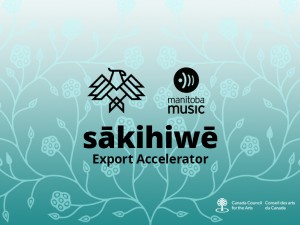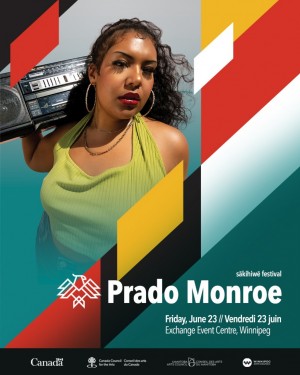sakihiwe news

Shared knowledge: concert planning
After seven years of producing Aboriginal Music Week, we're still learning about event production and we're still testing marketing ideas. Even though we're not experts in this field, we're ready to share some of our insights, practices, and lessons learned with the hopes that our relatives across the continent can side step some of the mistakes and challenges that we've had to overcome.
Below you'll find an example of a critical path or work plan that we would work super hard to follow for a fictitious concert with four acts, ticketed at $15 and set for February 19, 2016. Of course it's possible to put together concerts without most of this planning and detail, but we also think that real growth within the Aboriginal music community will only happen if First Nation, Metis, and Inuit presenters professionalize alongside our artists so we encourage all our brothers and sisters engaged in music presentation to dig in.
The underlying assumptions of our fictitious model include:
- Aboriginal Music Manitoba (AMM) serves as the executive producer and handles all initial details and contracting on a voluntary basis since we don't have full time staff.
- The concert is not part of a concert series or festival.
- It will probably take at least three months to confirm a cash sponsor and two months of marketing a concert is needed.
- The Aboriginal music community is still developing so AMM will contract artists with guarantees, provide accommodations, pay for backline, and assume all financial risks.
- The artists can access funding for travel, fit the concert into an existing tour, or cover the cost of ground transportation.
- The artists already have outstanding promotional photographs and high quality videos online that we can use to market the concert.
- AMM can use it's aboriginalmusicweek.ca website, email list, media database, and social networks, which already exist, to get the message out (i.e. AMM isn't starting from scratch).
Critical Path
- Aug. 28, 2015: Identify programming priorities, venue, partners, and marketing ideas
- Sept. 1: Develop budget and set fundraising targets
- Sept. 2: Identify potential sponsors
- Sept. 7: Develop sponsorship strategy and package
- Sept. 8: Book the venue and identify all costs associated with the venue
- Sept. 9: Request meetings with potential sponsors, distribute sponsor packages
- Sept. 14: Develop the marketing plan
- Sept. 15: Identify headliner and opening acts (along with alternates)
- Sept. 16: Send offers to primary artists with a September 29 expiration date
- Sept. 30: Send offers to alternates with October 12 expiration date
- Oct. 1: Send contracts to artists who accept the offer
- Oct. 5: Follow up with potential sponsors
- Oct. 13: Send contracts to alternates who accept the offer
- Oct. 14: Request stage plots, tech riders, bios, photos, video links, and cell numbers
- Oct. 21: All contracts signed, hotel bookings begin
- Oct. 28: Send reminders about stage plots, tech riders, bios, photos, videos, cells
- Nov. 10: Confirm insurance coverage and additional insured details
- Nov. 23: Art direction, photos, and event details sent to graphic designer
- Dec. 1: Concert brand complete
- Dec. 2: License three songs for a digital mixtape from artists who don't already have their music available on SoundCloud
- Dec. 8: Presenting sponsor confirmed, logos requested
- Dec. 10: Sponsor logo added to concert brand
- Dec. 14: Design of social media images complete, tickets sent to print
- Dec. 15: Add concert details to our website
- Dec. 16: Distribute press release about the concert, tickets on sale, launch Facebook ad campaign
- Dec. 17: Send an enews post about the concert to all Aboriginal Music Week subscribers
- Jan. 12, 2016: Book backline (and PA if needed) and confirm sound tech with venue
- Jan. 13: First run of posters distributed
- Jan. 13: Publish digital mixtape on SoundCloud with three songs by each artist
- Jan. 19: Distribute press release to highlight the digital mixtape and remind media about the concert
- Jan. 20: Send an enews post about the digital mixtape
- Jan. 23: Production schedule complete and sent by email to artists/agents/managers
- Jan. 24: Send production schedule to sponsor and confirm type of presence they require (signs/banners, promotions team, representative to speak to the audience, etc)
- Feb. 2: Schedule interviews for artists with local media
- Feb. 3: Second run of posters distributed
- Feb. 4: Contract event manager/stage manager, box office staff, and merch table staff
- Feb. 5: Send production schedule and artist cell phone numbers to event manager and introduce them to the sponsor.
- Feb. 8: Daily Instragram and Twitter posts begin. Concert host/MC is contracted.
- Feb. 9: Event manager calls each artist/agent/manager to confirm all details and to work out the merch table details (artists provide price tags, inventory, display, inventory list, and float). Event manager call the sponsor to confirm all details.
- Feb. 10: Event manager confirms load in times, sound check, and production schedule with venue
- Feb. 11: Concert host/MC receives the speaking notes by email
- Feb. 15: Radio ad campaign begins
- Feb. 16: Third and final run of posters distributed. AMM gets ticket sales report from all outlets so they can provide the venue with an attendance projection.
- Feb. 17: Event manager confirms security needs with venue and calls other staff to confirm details
- Feb. 18: Process all payments (artists, venue, staff, backline), withdraw cash for box office float, print box office tracking form, and print audience surveys to collect feedback. Give all payments, float, tracking form, audience surveys, and AMM banners to the event manager
- Feb. 19: Event manager arrives before the backline provider to oversee load-in, help with set up, and run the sound check. Sound check is for two acts at most and runs in reverse order to the performance schedule. Box office staff and merch table staff arrive 30 minutes before doors open to get set up. Concert happens and nothing goes wrong. Artists and staff receive payment immediately after their performance or shift. Merch sales are reconciled with artists. Box office revenue is collected by AMM for deposit.
- Feb. 24: Submit report and payment to SOCAN (Tariff 4A1)
It's important to note that even though we work hard to maintain these timelines and practices, life happens for us and it happens for the artists we work with, so flexibility and respect are the key ingredients for a successful concert.
The basic ideas:
- Start early and have a plan with a detailed budget.
- Provide expiration dates with all offers so you can manage project timelines.
- Give yourself at least three months to confirm a cash sponsor.
- The media might not be interested in your concert, so your own website, social networks, and email lists are important.
- Spend at least two months marketing the concert.
- Postering in a city is super competitive and posters get covered up after a couple days, so multiple runs are needed (if you can afford it).
- Create a production schedule with load in times, sound check details, the performance schedule, backline details, and cell phone numbers for all artists, staff, and service providers that everyone can reference.
- Call the artists/agents/managers to confirm details after sending them by email.
Please feel free to add notes or comments about your experience. We're not experts and we would love the opportunity to fine tune our models with your input and advice.









